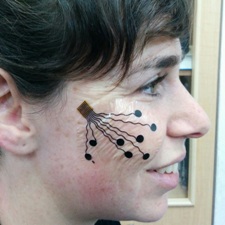These electronic face tattoos can track emotions and muscle activity
Considering a new tattoo? How about one that can actually measure the activity of muscle and nerve cells?
Researchers from Tel Aviv University have just developed a nanotech “tattoo” that can do just that, and its expected to change the medical and rehabilitation fields. The technology could even have potential applications in business and marketing research.
The electronic tattoo is comprised of a carbon electrode, an adhesive surface that attaches to the skin, and a nanotechnology-based conductive polymer coating that enhances the electrode’s performance. It records a strong, steady signal for hours and is said to do so without irritating the skin.

The electrode, was developed by Professor Yael Hanein, head of TAU’s Center for Nanoscience and Nanotechnology, and is poised to improve the therapeutic restoration of damaged nerves and tissue, as well as lead to new insights into emotions.
The researchers revealed that the new electrode is capable of mapping emotions by monitoring facial expressions via electrical signals that are picked up from facial muscles.
Being able to track and map human emotion could have many uses, including advertising and media, in order to test reactions to different products. The technology could take the place of questionnaires.
“Researchers worldwide are trying to develop methods for mapping emotions by analyzing facial expressions, mostly via photos and smart software,”said Hanein. “But our skin electrode provides a more direct and convenient solution.”
Originally, the tattoo was developed as an alternative to electromyography, which assesses the health of muscles and nerve cells. The process is normally uncomfortable and requires patients to lie in the lab for hours at a time. The procedure usually requires that a needle be stuck into muscle tissue to record electrical activity, or have patients swabbed with a cold, sticky gel and attached to surface electrodes.
“Our tattoo permits patients to carry on with their daily routines, while the electrode monitors their muscle and nerve activity,” said Hanein. “The idea is: stick it on and forget about it.”
According to the team, the electrode has other important therapeutic applications such as monitoring the muscle activity of patients with neurodegenerative diseases.
“The physiological data measured in specific muscles may be used in the future to indicate the alertness of drivers on the road; patients in rehabilitation following stroke or brain injury may utilize the ‘tattoo’ to improve muscle control; and amputees may employ it to move artificial limbs with remaining muscles,” added Hanein.

Comments are closed, but trackbacks and pingbacks are open.